Column: Spring Rowing on Argo Pond
It’s late March and I’m lingering around the end of the boathouse used by the Pioneer High School rowing team, waiting for the boats to head down to the water for practice. Coach Rich Griffith has agreed to let me ride along in the motorized launch as he monitors the rowers’ workout. The following week I’ll take a ride with Huron High’s coach, Tom Kraft.
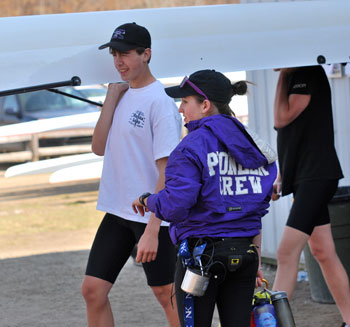
Alec Washabaugh helps carry the boat as Meaghan Kennedy directs traffic. Both are students at Pioneer High School. Next fall, Kennedy will be heading to Indiana University in Bloomington, where she’ll attend school on a crew scholarship. (Photos by the writer.)
From behind me comes the warning from one of the coxswains: “Heads up!” Coxswains steer the boats on the water – and on land as well, because lifting and turning the long craft requires coordination.
A peek over my shoulder confirms that the command is directed at me – I’m standing near the middle of an upside-down 8-person rowing shell held aloft by eight women. My noggin is safe for a few seconds as they pause. To clear the boat completely, I’d need to hustle a good 25 feet in one direction or the other. But that seems like an overly dramatic and panicky move. Surely that’s not what boathouse culture demands? Instead, I simply kneel. The boat makes its way over me and down to the dock.
The learning curve is steep. A few minutes later: “Heads up!” The scene repeats itself.
I confirm with Pioneer senior Meaghan Kennedy, who’s standing nearby, that yes, maybe I should find another vantage point. Kennedy is coxswain for the men’s varsity eight-man boat and one of the team’s captains, along with twins Zach and Mackenzie Miller. Kennedy is waiting to guide her own boat down to the dock.
Who Pays for This?
The Chronicle’s report of the March 24, 2010 meeting of the Ann Arbor Public Schools board of trustees includes details on this year’s proposed budget, which features a new “pay-to-play” program for athletics [emphasis added]:
[Superintendent Todd] Roberts emphasized that it was a goal for extracurricular activities not to prevent any student from participating. The cost to participate in high school sports would be $150 for the first sport, and $50 for every sport thereafter. In middle school, there would simply be one $50 athletic fee for any number of sports played over one year. Scholarships would be available, he said, for athletics, as well as to cover the musical instrument fees.
Up to now, the fee assessed by the district has been $35 to cover insurance for sports sanctioned by the Michigan High School Athletic Association. Rowing is not a sanctioned sport.
Coaches Griffith at Pioneer High School and Kraft at Huron High say the pay-to-play system will have an impact on their programs. Griffith told The Chronicle his rowers already pay $580 a year. For a fall and spring seasons rower, the proposed system would mean $200 more, pushing the total to $780. Griffith says that could give some of his 73 rowers this year pause. And if fewer students come out for the sport, that will nudge the cost higher still – the $580 cost is calculated by taking the budget set by the nonprofit Pioneer Rowing Club and dividing by the number of rowers.

Not a financial bailout. Huron High rowing coach Tom Kraft empties some water out of the launch from the previous day’s rain.
Kraft has similar concerns. The Huron Rowing Association is the nonprofit that oversees the capital investment and operations for the Huron High School team. Cost per rower per season is $275, which comes to$550 for a full year. Kraft notes that some scholarship money is available. One obligation that scholarships don’t cover, says Kraft, is the 400 points worth of fundraising effort each rower needs to contribute. There’s a point system for volunteering with various fundraisers – a deficit in points gets paid at a 1 point = 1 dollar conversion.
The school system supports the rowing program with funds for coaches and travel.
The rowers are not alone in already paying something to support their participation in athletics. All 38 varsity sports at each of the two high schools have associated booster clubs. The check that Pioneer golfers write to the booster club, for example, is $200. But in a phone interview, Liz Margolis, spokeswoman for Ann Arbor Public Schools, stressed that no student can be prevented from participating in a sport due to failure to pay a booster club fee. The same will be true of the pay-to-play system, Margolis said.
Out on the Water with Pioneer Crew: “A Fool Maid of Honor”
From the dock downstream, to the south, it’s about 500 meters to Argo Dam. Once the two racing shells – one 8-man and the other a 4-man – have made their way to the dam end of the pond, Coach Griffith checks in with them from our launch. Before we’d left shore he had searched the boat house for one of the bullhorns, but found only a megaphone – just a cone with no electronic amplification. He tests it out: “Is this at all a viable means of communication?” The indication from the rowers is, no, not really. But they make do.
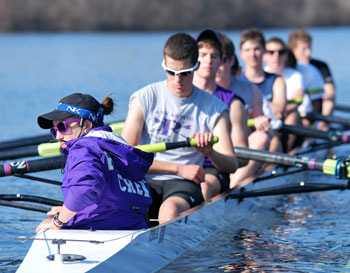
Out on the water from foreground to background: Meaghan Kennedy, Zach Miller, Drew McMillan, Lucas Kennedy, Konstantinos Papefthymiou, Liad Lehavy, Nick Terrell.
Griffith starts them off with a two-pause drill. He wants them to interject “hiccup pauses” to make sure they get good “send” to the boat. The coxswains – Meaghan Kennedy for the 8-man and Zack Ackerman in the 4-man – are to call out the pauses to the crew.
We make our way back upstream well past the dock. Griffith admonishes the rowers, to “roll up together” better. We encounter some other rowing shells, and a kayaker who’s out on the pond that day, so Griffith hangs back with his motor launch. He doesn’t want to subject them to the wake from our boat.
We stop short of the US-23 bridge and turn around. The assigned drill – back up towards the dam – involves increasing the stroke rate every 20 strokes for 10 strokes at a time. This cadence is monitored by the coxswains, who are fed data from a rowing computer. The rowing computer works on the same principle as modern bicycling computers that count wheel rotations with a magnet.
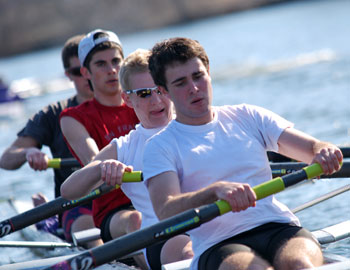
Pioneer men’s team, foreground to background: Henry MacConnel, Josh LaHaye, David Chapman, Chris Darnton, Zack Ackerman (coxswain, hand only – look for the purple swatch at the edge of the frame).
In the racing shell, a magnet under the seat of the first rower – the stroke seat – tickles a sensor each time it slides past. The computer automatically calculates the stroke rate based on elapsed time.
Griffith has the boats practice their starts. “Sit ready! Attention! Row!” is the command sequence. He focuses his rowers on body angle – they’re laying back too far at the end of the stroke during the starts. With high stroke cadences, he tells them, they can cut off the lay back – there’s no need to go past vertical.
I switch out of Griffith’s boat and climb aboard a launch with women’s coach Suzanne Buzzell. “Buzz” did her collegiate rowing at Michigan State University. She’s putting an 8-woman boat through its paces. They’re working on building up to a stroke rate of 32 per minute. Buzz is focusing them on their “catches” – the part of the stroke when the oar blade first enters the water: “Keep the catches light! Let the blade fall right in! Effortless catches!”

Pioneer women’s team: Sarah Foster (coxswain), Hannah Graham, Annika Gage, Anna DeBoer, Claire Barrett, Rachel Bielajew, Ella Janowitz, Annie Oldani, Kendall Phillips.
And then, “Fool maid of honor!” Surely this was the distortion from the bullhorn? Or the way sound travels across the open water? [Unlike Griffith, Buzz had managed to snag an electronic bullhorn from the boat house.] A few more repetitions allow the actual words to settle acoustically in my ear: “Full blade of water.” Ah. That makes somewhat more sense.
At the end of the stroke, Buzz wants the blades coming out squared and clean: “Don’t throw up that water!” Although Buzz is focused on giving technical feedback, she explains to me that underlying the technical work is an aerobic- and stamina-building drill.
Well past the US-23 and railroad bridges not far from Barton Dam, we turn around. The kayaker, who’s been following at a distance, approaches and asks if he’s bugging us. No, he’s fine, says Buzz. She asks if he’s trying to race them. He confirms that he is. He’s fine just as long as he doesn’t run into them, Buzz advises.
The women in the boat want to hear from Buzz how they’re doing. Asks one, “Are my shoulders staying down?” Buzz’s frank assessment: “Yes – when I yell at you!” Another wants to know, “Is my handle height at the catch getting better?” Again, Buzz doesn’t tell give her the unconditional praise she’s probably hoping to hear: “When I yell at you – yes.”
The practice for this boat wraps up with some start drills. The idea is to start with a five-stroke sequence with increasing power: half, half, three-quarter, full, full. That five-stroke sequence segues into 5 full strokes.
They’re trying to get the stroke rate up as high as possible. After several start drills, Buzz asks coxswain Sarah Foster for a report. They’ve been hitting between 31 and 32 strokes per minute with a high of 33.
Buzz tells them for the final drill she’d like to see a 36: “That’s doable,” she assures them. As they set off in search of a 36, Buzz exhorts them: “See how high you can get it. Have fun with this, ladies! Send it!”
The report back from Foster: 35 and a half. Asks Buzz, “Seriously?” Yep. Buzz tells them to stroke it into the dock. The 36 will apparently be left for another day.
But no.
Annika Gage, rowing in the second seat, wants to take another shot at 36. Buzz obliges, giving them 15 strokes after the initial five, to get to 36 strokes per minute. “Sit ready! Attention! Row!” And 20 strokes later Foster announces their victory for the afternoon: “36 and a half!”
Out on the Water with Huron Crew
It’s a week later now. Huron High coach Tom Kraft and I are waiting outside the boat house as assistants Ted Deakin, Jerry Hoffman and Mike Dove tell the team how practice will work that day. Kraft tells me that Dove should be credited with getting the Huron rowing program started. After helping with Pioneer for a few years, he’s now back at Huron.

Huron High rowers Peter Dolce (left) and Matt Goolsby (right) before they were asked to “sit ready.”
The workout will be an experiment, says Kraft, combining the novice (first-year) rowers with varsity. Four novice rowers and four varsity rowers will sit in each boat. It’s a way for novice rowers to learn more quickly, Kraft says.
As we head out on the water, it’s windy – windy to the point that Kraft notes that the coxswains will need to be extra mindful, given the less experienced rowers in the boats. He also tells the oarsmen to be focused on the commands they hear from the coxswains: “If they ask you to row, you row, don’t make the coxies ask twice.”
After collecting the boats – three 8-man racing shells and two coaches launches – near the dam end of Argo, the warm up starts heading north. They start with six people rowing, the other two just “setting” the boat – that is, balancing it. As they make their way up the pond, one of the three boats is clearly zipping along faster than the others. “Somehow that boat got loaded up with strong guys,” comments Kraft.
Kraft gives pointers: “Make sure it’s the outside hand doing the work!” “Get your hands out in front of your knees, sit up tall.”
After warming up, their first workout piece is seven minutes long with increasing stroke rates. In terms of stroke rate, here’s what it looks like:
1 minute at 24 spm 2 minutes at 26 spm 3 minutes at 28 spm 1 minute at 30 spm
-
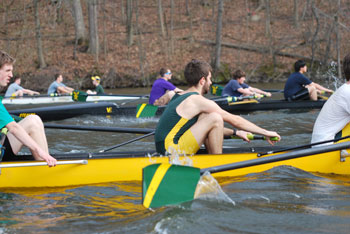
Huron High School oar blade, just before the catch. In the center of the frame is Drew Baxter. Matt Schulte, sitting behind Baxter, is setting the boat during this warm-up phase.
With varsity-level rowers in every seat, Kraft said, they’d do 36-38 strokes per minute for an entire piece. For novices, 32 strokes might be all they could handle.
After the piece is done, Mike Dove gets them started on their second piece – it will be a five-stroke start. “All boats sitting ready! Attention! Row!”
Kraft notes that for some of the rowers that is surely only their second-ever racing start. But then he observes, “They got through it. And nobody died!”
Regatta: Hebda Cup
Coming up on the schedule for the Huron and Pioneer rowing teams is the Hebda Cup in Wyandotte on April 24. There are around 20 races scheduled between 8 a.m. and 10:30 a.m. that Saturday. The drive to Wyandotte, from Ann Arbor takes around an hour.




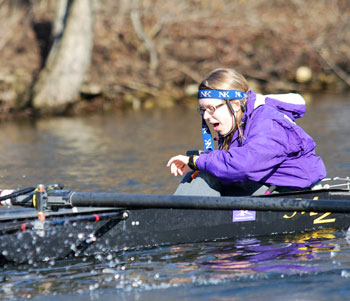
Great article! This really gives you a feel for the great sport of rowing. My daughter rowed for 3 years at Pioneer and loved it. Coach Griffith does a superb job of getting the team ready for regattas. I also took a learn to row class with Coach Kraft who did a great job teaching a bunch of out-of-shape adults how to work together as a crew. With Coach Dove, Ann Arbor schools are lucky to have three such dedicated and experienced coaches.
I heard the new Skyline Rowing team is being excluded from the river? Is this true?
[2] Re: possible “exclusion” from the river.
I do not believe it’s the case that Skyline is being excluded from the river. However, I’ll try to follow up as time permits.
No, it is not true that Skyline is excluded. They are rowing on the same water as the other two high school teams.
Why not look at the Skyline team too? My daughter is going to Skyline next year and is considering crew. They have a brand new team and we’d like to see some reporting on them as well.
As a resident of the neighborhood, and frequent kayaker on the river, I would truly welcome the absence of the rowing teams.
It should not be the kayakers asking if they are bothering the rowers but the other way around. Gallup is a much more suitable place for their practice as it’s not located directly in a neighborhood, is much bigger and gives the rowers plenty of room to practice without disturbing the other people trying to enjoy the river in this area.
Gallup park is far better suited to kayakers and is not long enough to accommodate the area’s rowing teams. Besides that – there are no facilities at Gallup to store boats and launches, and no funding available to build any at this time. The estimated 600-700 high school, University and masters rowers who use Argo are also “trying to enjoy the river in this area” and should be given the same consideration as the kayakers.
Pull the plug on Argo dam.
Thank you for the informative and positive article! All three high school programs work closely together and are fine examples of sportsmanship in every sense. Although the rowing community has had it’s share of criticism lately, the unexpected result is a more cohesive rowing community, increased local support and exposure, to a truly beautiful sport.
Hi,
I am the Head Coach for Skyline Crew Team.
We have not been excluded from Argo and are currently practicing there every night. We will be looking for new water for the fall as there is a significant congestion issue. This I see only as a good thing, the expansion of the sport will have a positive impact on new students and members of the Ann Arbor community.
We are currently a club sport at Skyline and therefore not financially supported. The pay to play will make things difficult for us, but we will push on. We want as many kids as possible given the chance to see what a wonderful sport crew is.
I would welcome Dave to contact me to see how our brand new team is doing, these are exciting times for Skyline Crew. Our Spring racing schedule kicks off this weekend in Grand Rapids and will finish on May 15th with the State Championships.
I wish all the teams the best of luck this season!
Using similar logic to #6 – I think traffic in town on football Saturdays is unbearable and demand the University of Michigan find someplace else to play!
I wonder why rowers don’t use Barton Pond. Too windy? No facilities? Seems like a boathouse at Barton Park would be a possibility.
Rod,
That is something that has been looked at. Sadly access is a problem. The city land is too difficult to access due to the rail tracks and the other entry points to water fall under Barton Village. The village sadly does not want increased traffic due to a rowing team being added to the pond.
I was thinking about the Huron River Drive side, and yeah, I know about the railroad issue. Damn railroads! Doesn’t the UM Sailing club have a place on the BH side?
I love seeing the rowers on Argo Pond and hope they stay where they are! It brings a vibrancy and life to this section of the river.
Unfortunately there is no consideration given to the Kayakers on this stretch of the river and that is why I feel the way I do about Gallup Park being better suited for the Rowers. As I said it is not in a neighborhood and there are docks where they can access the river easily. People frequenting Gallup expect to see that type of activity there as it is a public recreational park.
I grew up in the neighborhood very near the Michigan Stadium and loved the activity the football games generate..I love the Huron River in my neighborhood now and would enjoy the peace and serenity it offers if not for the bullhorns and intrusive rowers.
I know that other revenues have been considered for rowing and Gallup Park was found to be short of rowable water (I’ve heard that 3000 meters is considered the minimum needed). The bridges at Gallup are also too narrow for rowing shells to pass through. It would also be very expensive to move the boathouse to Gallup Park.
My point is that you (and others) seem to be targeting rowing while you do not mention any problems with the noise and crowding associated with other sports/activities. Have you ever been around the high school football or baseball fields during practice or games? They can be very noisy and the traffic can backup. How you ever been inconvenienced by street closures due to road races? All are part of living in Ann Arbor and I like living in Ann Arbor.
There are some 200 to 300 hundred rowers (including Skyline, Huron and Pioneer High School teams, the U of M Men’s team, and the Ann Arbor Rowing Club) on Argo Pond between 3 PM and 8 PM every weekday afternoon from mid August to late October and mid March to late May. I am amazed at the organization and courtesy required by everyone involved to make that happen. I have seen kayaks and canoes on the water at the same time as the crew teams and they must follow the same navigational rules as everyone else to ensure everyone’s safety. Is it better when no one else is on the water and one can have the pond all to themselves? You betcha! But that does not happen very often in rowing season between 3 and 8 PM.
I think rowing on Argo Pond is one of the many things that make Ann Arbor unique and a more livable city.
I do appreciate your point of view #17 and I am not anti sports at all. However, traffic is one thing~we expect that and if this was a sports complex for rowers then I would expect traffic around that as well. It is not a sports complex for the schools however, so it is different than the Stadium or the Hockey fields or Chrysler Arena, or an event at one of the High Schools. This is the River and when I encounter someone else enjoying leisurely recreation on the river I highly respect their right to be there..If there were 10 rowers enjoying the river and then pulled out bullhorns and put motors on their boats I would call that activity inappropriate for the Huron River as well and I would say they are disturbing the peace and would be asking are motors even allowed on the River? Just because these rowers, with bullhorns and motors on the rowboats, are organized sports doesn’t make it any more appropriate.
Don’t the City’s rules for Argo Pond forbid or restrict the use of electronic bullhorns?